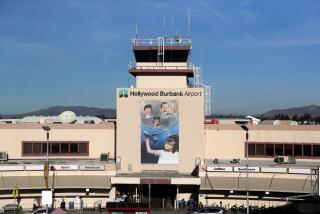FAA May Look Into Burbank Airport Plans
- Share via
The long, politically charged feud between Burbank and the regional airport over replacing its 70-year-old terminal suddenly has taken a back seat to security in the wake of the Sept. 11 terrorist strikes on the United States.
Although no one is saying the Federal Aviation Administration would order the construction of a new terminal, experts said the federal agency could intervene in such issues in an effort to make regional airports safer.
“The federal government has traditionally left decisions about running airports as well as when, where, and whether to build airport facilities to local communities,” said Peter Kirsch, special counsel for Burbank on airport issues. “But security concerns may expand their [FAA] reach into all of these areas.”
Already, local airport officials have been reexamining capital improvement and expansion projects amid stepped-up security. Los Angeles International Airport announced last week that it would review a controversial $12-billion expansion with a focus on security.
The Burbank-Glendale-Pasadena Airport Authority followed suit, announcing it would suspend plans for a new $300-million, 14-gate terminal because of security and financial uncertainty arising from the Sept. 11 attacks.
With a $15-billion aid package already promised to the flagging airline industry, the federal government is likely to examine all aspects of the nation’s air systems, including terminal upgrades, said Rep. Howard L. Berman (D-Mission Hills).
“It’s a process . . . when one thing comes into play, all things come into play,” said Berman, who also noted that Burbank Airport would be low on the nation’s long list of aviation priorities.
But others, including a representative for a national airport group, contend the FAA is so firmly entrenched in every aspect of airport regulation, there is little room for additional government involvement in local matters.
“The FAA is directly involved in the approval of all airport design modifications and as far as noise and curfews go, the government has well-established regulatory requirements that must be met before the FAA will consider discussing the matter,” said Bonnie Wilson, vice president of airport facilities and services at Airports Council International.
“In all, I don’t see much more of a role for government than they already have,” she said.
At Burbank Airport, which serves about 4.7 million passengers a year, opponents of the terminal expansion have long pushed for a mandatory overnight curfew on commercial flights over their San Fernando Valley neighborhoods.
That persistence, coupled with timely court victories, led to a 1999 compromise that would have allowed the airport to build a $300-million, 14-gate terminal on land owned by Lockheed Martin Corp.
But the deal fell apart after the airlines complained it constituted illegal interference with airport operations, and local residents said it did not offer enough protection from aircraft noise.
Burbank Airport then put 81 acres of the 130-acre Lockheed Martin site up for sale and hired consultants to evaluate a 41-acre parcel on the southwest side of the airport for a 14-gate terminal.
That was before plans for a new terminal were placed on indefinite hold.
“The FAA isn’t going to save this terminal,” said former City Councilman Ted McConkey, a key proponent of an initiative on the Oct. 9 Burbank ballot that proposes further limits by requiring that capital projects be subject to City Council approval.
“The federal government isn’t going to dictate whether or not to build a terminal,” he added.
But Burbank Airport attorney Richard Simon says nobody can predict what will happen.
“Any attempt today to prognosticate as to what the FAA’s role at this or any other airport will be a year from now is simply misplaced,” Simon said. “It’s guesswork.”
More to Read
Sign up for Essential California
The most important California stories and recommendations in your inbox every morning.
You may occasionally receive promotional content from the Los Angeles Times.













